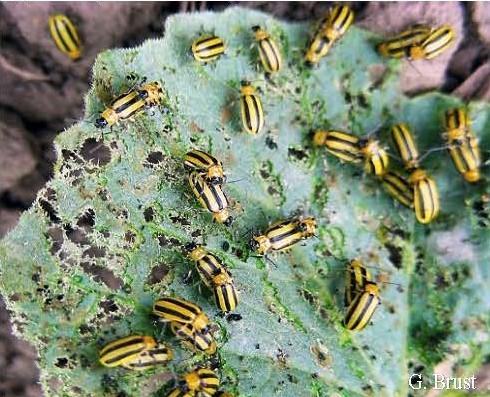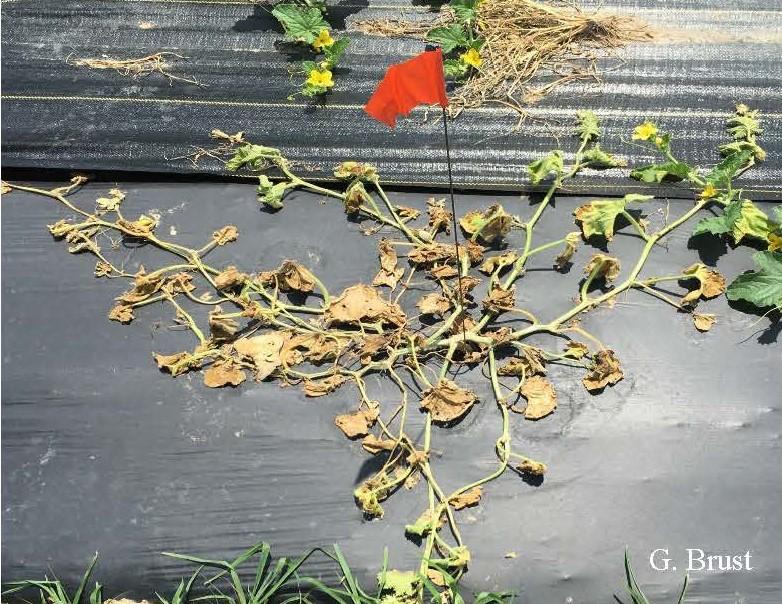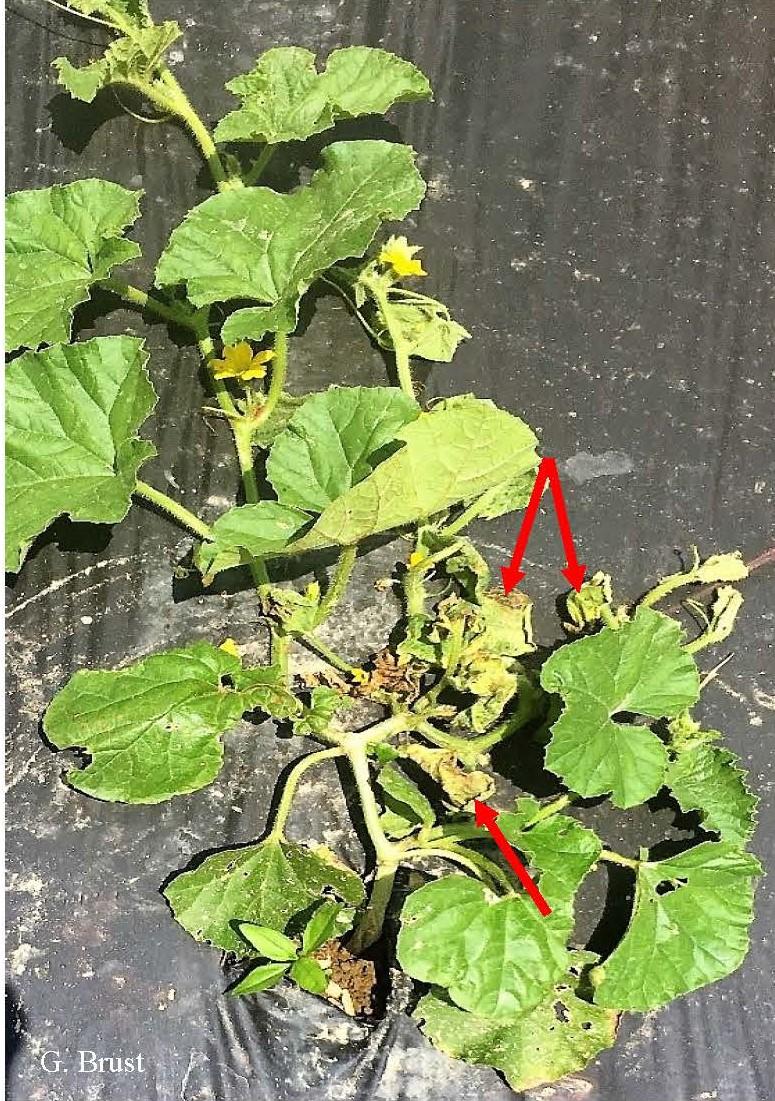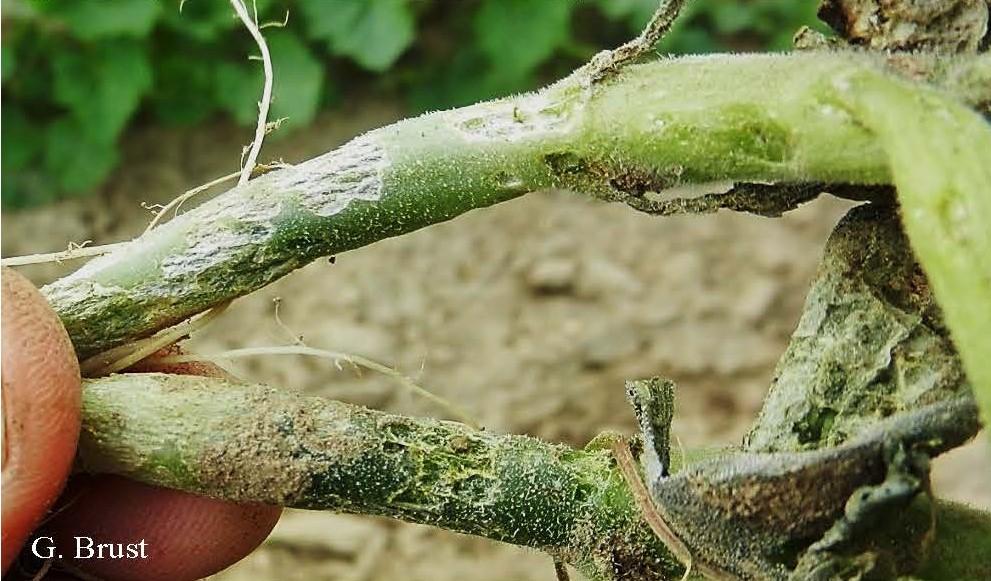Striped Cucumber Beetles and Bacterial Wilt
Striped cucumber beetles (Acalymma vittatum) (SCB) are the most important insect pests of muskmelon and cucumbers in our area. They overwinter as adults and emerge when temperatures reach 54–62°F at which time they begin searching for cucurbit hosts. Volatiles produced by the plant attracts SCB to cucurbits initially, then male SCBs produce an aggregation pheromone attracting more beetles. The beetles tend to mass on small plants where they eat, mate and defecate (fig 1). This type of frenzied activity where there are many beetles feeding on a few leaves or a small plant leads to increased chances of bacterial wilt development. The bacterium that causes bacterial wilt in cucurbits, Erwinia tracheiphila, is in the cucumber beetle’s feces. As the beetles defecate on the leaves where they are feeding the bacteria can be moved into open (feeding) wounds with water that is in the form of precipitation or dew. The more beetles that are feeding and opening wounds on susceptible crops like cucumbers and cantaloupe the greater the chance of bacterial wilt infection. The bacteria multiply and block plant xylem, restricting water flow to the rest of the plant; plants wilt and eventually die (fig 2). The wilting usually starts with just one heavily chewed upon leaf wilting and then this wilting progresses to the stem of the leaf and then to major vines of the plant. This process of vines and the entire plant wilting down can take 2-6 weeks after initial infection, but because the non-infected parts of the plant continue to grow growers might think when they see a plant wilt down that infection took place just within the last few days (fig 3).
One additional problem with SCB and why control sprays may not work as well as they should under some conditions is that the beetles are consistently hiding at the base of the plant (in the plastic hole) where they are feeding on the stem (fig 4). Sprayers are set up usually to cover a lot of leaf canopy and often do not do a very good job of putting chemical down in the plant hole. This stem feeding can be severe enough to cause some wilting. It is hard enough to control cucumber beetles with a good cover spray, but when only small amounts of spray are reaching them down in the plastic hole they will not be controlled.
Melon cultivars have different susceptibilities to bacterial wilt infection. Watermelon is almost immune to infection while squash and pumpkin are moderately susceptible. Cantaloupe and cucumbers as well as some of the specialty melon types are much more susceptible. Among the most susceptible cultivars are, Honeydew 252 and HD150 which are honeydew melons; Da Vinci which is a Tuscan type melon and Miracle and Sheba which are a netted yellow-green melons. Among the most tolerant cantaloupe cultivars are Aphrodite, Athena, Accolade and Astound which are all eastern cantaloupes and just happen to all start with A. The management methods that are recommended for bacterial wilt control for standard cantaloupe varieties (using seed treatments and insecticides when beetles reach 1 per plant or using kaolin clay or row covers before beetles appear) work well. For the specialty melons more attention is needed to carefully follow management recommendations.
 English
English العربية
العربية Български
Български 简体中文
简体中文 繁體中文
繁體中文 Hrvatski
Hrvatski Čeština
Čeština Dansk
Dansk Nederlands
Nederlands Suomi
Suomi Français
Français Deutsch
Deutsch Ελληνικά
Ελληνικά हिन्दी
हिन्दी Italiano
Italiano 日本語
日本語 한국어
한국어 Norsk bokmål
Norsk bokmål Polski
Polski Português
Português Română
Română Русский
Русский Español
Español Svenska
Svenska Català
Català Filipino
Filipino עִבְרִית
עִבְרִית Bahasa Indonesia
Bahasa Indonesia Latviešu valoda
Latviešu valoda Lietuvių kalba
Lietuvių kalba Српски језик
Српски језик Slovenčina
Slovenčina Slovenščina
Slovenščina Українська
Українська Tiếng Việt
Tiếng Việt Shqip
Shqip Eesti
Eesti Galego
Galego Magyar
Magyar Maltese
Maltese ไทย
ไทย Türkçe
Türkçe فارسی
فارسی Afrikaans
Afrikaans Bahasa Melayu
Bahasa Melayu Kiswahili
Kiswahili Gaeilge
Gaeilge Cymraeg
Cymraeg Беларуская мова
Беларуская мова Íslenska
Íslenska Македонски јазик
Македонски јазик יידיש
יידיש Հայերեն
Հայերեն Azərbaycan dili
Azərbaycan dili Euskara
Euskara ქართული
ქართული Kreyol ayisyen
Kreyol ayisyen اردو
اردو বাংলা
বাংলা Bosanski
Bosanski Cebuano
Cebuano Esperanto
Esperanto ગુજરાતી
ગુજરાતી Harshen Hausa
Harshen Hausa Hmong
Hmong Igbo
Igbo Basa Jawa
Basa Jawa ಕನ್ನಡ
ಕನ್ನಡ ភាសាខ្មែរ
ភាសាខ្មែរ ພາສາລາວ
ພາສາລາວ Latin
Latin Te Reo Māori
Te Reo Māori मराठी
मराठी Монгол
Монгол नेपाली
नेपाली ਪੰਜਾਬੀ
ਪੰਜਾਬੀ Afsoomaali
Afsoomaali தமிழ்
தமிழ் తెలుగు
తెలుగు Yorùbá
Yorùbá Zulu
Zulu ဗမာစာ
ဗမာစာ Chichewa
Chichewa Қазақ тілі
Қазақ тілі Malagasy
Malagasy മലയാളം
മലയാളം සිංහල
සිංහල Sesotho
Sesotho Basa Sunda
Basa Sunda Тоҷикӣ
Тоҷикӣ O‘zbekcha
O‘zbekcha አማርኛ
አማርኛ Corsu
Corsu Ōlelo Hawaiʻi
Ōlelo Hawaiʻi كوردی
كوردی Кыргызча
Кыргызча Lëtzebuergesch
Lëtzebuergesch پښتو
پښتو Samoan
Samoan Gàidhlig
Gàidhlig Shona
Shona سنڌي
سنڌي Frysk
Frysk isiXhosa
isiXhosa


